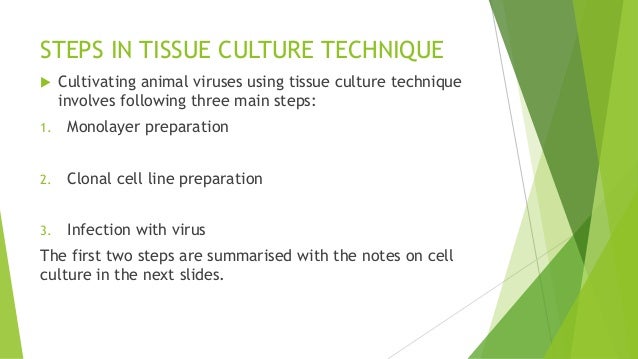
Human and monkey cells are used in both traditional viral culture and shell vial culture. Human virus types that can be identified by viral culture include adenovirus, cytomegalovirus, enteroviruses, herpes simplex virus, influenza virus, parainfluenza virus, rhinovirus, respiratory syncytial virus, varicella zoster virus, measles and mumps. Techniques of Virus Cultivation. They cannot be grown in non-living culture media or on agar plates alone, they must require living cells to support their replication. Individual Methods. In this section. In addition EM may be used to confirm the results of virus isolation by cell culture such as for parainfluenza viruses.
Animal and plant viruses are cultivated in cell cultures. A cell culture is prepared by encouraging cell growth outside the animal or plant source. The cells are kept alive in a suspension of growth factors within a Petri dish. A thin layer of cells, or monolayer, is then inoculated with viruses, and replication takes place. Fertilized eggs and living animals can also be used to cultivate viruses.
For research study, viruses can be cultivated in large volumes by inoculations to tissue culture systems. After a time, the cells are degenerated, and viruses are harvested. Volkswagen Touareg Radio Removal Tool here. The viral particles are concentrated by precipitation methods and purified by repeated centrifugations.
Highly purified viruses can be obtained by crystallization and concentration under established conditions. Viral measurements. Viruses are generally too small to be seen under the light microscope, and an electron microscope is usually necessary to make them visible. Although viruses can be quantified by observation, it is also possible to determine their number in terms of virus infectious units, each of which is the smallest unit that causes a detectable effect when viruses infect a susceptible host. Virus infectious units are expressed per volume of fluid. One method for determining virus infectious units is by the plaque assay. The plaque assay is performed by cultivating viruses on a “lawn” of host cells and noting the presence of clear areas where viruses have replicated and destroyed the cells.
Another way of determining virus infectious units is by cultivating viruses in living animals and determining which dilution of virus is lethal to the animals. The end-point dilution can be calculated by this method.
Antiviral agents. The antibiotics normally used to treat bacterial disease cannot be used to inactivate viruses because viruses do not perform the biochemical functions that antibiotics interfere with. For example, penicillin is used to interrupt the synthesis of the bacterial cell wall, but viruses have no cell wall. However, there are several nucleotide analog drugs that interfere with viral replication.
Acyclovir, for example, is used against herpes viruses because this drug prevents the synthesis of DNA during viral replication. A drug called azidothymidine (AZT) is used for patients with HIV infection because this drug also prevents the synthesis of DNA. A drug called ganciclovir is used against cytomegaloviruses, and amantadine is useful against influenza viruses.
Interferon, a naturally produced antiviral agent approved for certain uses, is a group of proteins produced by host cells after they have been infected by viruses. The interferons do not protect the host cell, but they do provide protection to neighboring cells against viral replication. Interferons can be produced by genetic engineering methods. Viral vaccines. Protection against viral disease can be rendered by using a viral vaccine. Viral vaccines can be composed of inactivated or attenuated viruses.
Inactivated viruses (“dead viruses”) are unable to replicate in host cells because of some chemical or physical treatment. The Salk vaccine against polio and the yellow fever vaccine are examples. Attenuated viruses (“live viruses”) are weakened viruses that replicate at a very slow rate in host cells and generally do not produce any symptoms of disease when inoculated to humans. Attenuated viruses are used in the Sabin polio vaccine and in the vaccines against measles and rubella. The most contemporary vaccines are composed of viral proteins produced by genetic engineering methods. The vaccine for hepatitis B is an example of this type of vaccine. Viral inactivation. Virus particles are composed of nucleic acid, protein, and in some cases, a lipid envelope.
As such, the viruses are susceptible to normal inactivation by chemical substances that react with any of these organic compounds. Such things as chlorine, iodine, phenol, detergents, and heavy metals rapidly inactivate viruses. In addition, viruses are destroyed by heating methods used for other microorganisms, and they are very susceptible to the effects of ultraviolet light. Filters can be used to remove viruses from fluids so long as the filter pores are small enough to trap viral particles.